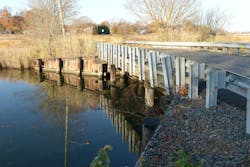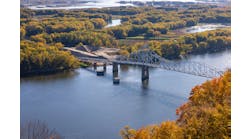Infrastructure improvements keep our communities safe, but they also create local jobs, generate positive environmental impacts, and are essential to improving real estate values and increasing access to communities.
They can, however, be expensive and time-consuming. A paradigm shift in the project planning and procurement approach where the need to minimize mobility impacts that occur due to onsite construction activities are elevated to a higher priority, the accelerated bridge construction (ABC) method is a cost-effective and innovative solution, and its advantages include reducing traffic issues, overall construction time, and weather-related time delays.
The R-27 bridge in Monmouth County, New Jersey, benefitted from this construction method. Its estimated traffic is around 2,000 vehicles per day, with a weight limit of 15 tons. The east-west bridge carries 4th Street between Keansburg Borough and Hazlet Township over Waackaack Creek, a tributary of Raritan Bay. The creek is not only home to wildlife and diverse plants, it’s also a popular recreation spot.
Initially built in 1945, and reconstructed in 1966, Bridge R-27 eventually became structurally deficient, and the county approved its replacement. The project site was in a residential neighborhood immediately east of the bridge, with tidal marshes to the west. The final design chosen for the new structure was a three-sided precast concrete culvert bridge because of its aesthetic, constructability, and durability.
Though the Bridge R-27 project was completed prior to the passage of President Biden’s $1.2 trillion Bipartisan Infrastructure Law, several bridges throughout New Jersey are now slated for repairs. In fact, the Garden State will receive $229.4 million annually over the next five years for bridge and road repairs. In total, the Federal Highway Administration rated nearly 500 of New Jersey’s 6,798 bridges as deficient in 2021. As these structures begin to undergo a much-needed overhaul, many of them could benefit from using the ABC method.
T&M Associates designed a new single-span bridge by completely removing the previous Bridge R-27, which was a 24-ft-wide, three-span timber structure. An engineering team at T&M Associates also worked on surveying and mapping, geotechnical engineering, utility coordination, and wetlands delineation, among other tasks. Other alternatives including traditional construction were evaluated, but unlike traditional construction, where most of the work is done on-site, ABC offered the most benefits, including decreased disruptions during construction and, hence, was preferred and selected by the owner, Monmouth County.
One major advantage of using ABC is that it reduces the construction duration. The project in its entirety took about six months, starting in February 2021 and ending last August 2021. Without ABC, it would have added three additional months to the schedule at a minimum. This schedule could have been further impacted due to weather and existing site conditions.
Using ABC also minimizes errors, which brings down costs for both material and labor. Because bridge components are fabricated off-site, it provides a better finish, requires less maintenance, and reduces on-site disturbances. The components that are cast are also inspected off-site and are ready for installation before a bridge closure. There is only assembly done at the construction site, and there’s a bonus that the use of precast materials provides a longer lifespan.
In this example with Bridge R-27, the bridge’s timber superstructure was replaced with a three-sided precast concrete culvert and a reinforced concrete cast-in-place riding surface that now spans 32ft. Its long-lasting durability proved vital as the Category 4 Hurricane Ida barreled through New Jersey, causing widespread flooding and damage. Because the lowest portion of the bridge is set above flood elevation, Bridge R-27 withstood the powerful storm last September.
The raised roadway with permanent sheeting along the roadway caused minimum impacts to coastal wetlands in the work project area. And once the precast materials were ready to be placed at the site, a cofferdam—a watertight enclosure that creates a dry working environment where crews can carry out other work safely—was used for installation. T&M Associates also conducted a threatened and endangered species habitat analysis and employed all the measures in the design necessary not to impact local species or their habitat during the construction. Area wildlife includes turtles, frogs, fish, and waterfowl. The area surrounding the bridge was restored to its original condition after the construction. This included plantings, safety measures such as guiderails, and pavement striping for added driver comfort.
In total, the reconstruction project cost $2.79 million, with 98% of funding from the New Jersey Department of Transportation’s Local Bridge Future Need grant allocation to Monmouth County (the county funded the rest of the cost). But we’re already seeing how this new structure pays for itself, especially when it comes to withstanding phenomena like last year’s destructive Category 4 Hurricane Ida, which caused fatalities and millions of dollars in damages in our state. The overall team’s success was due to the collaborative and dedicated efforts by all stakeholders.



